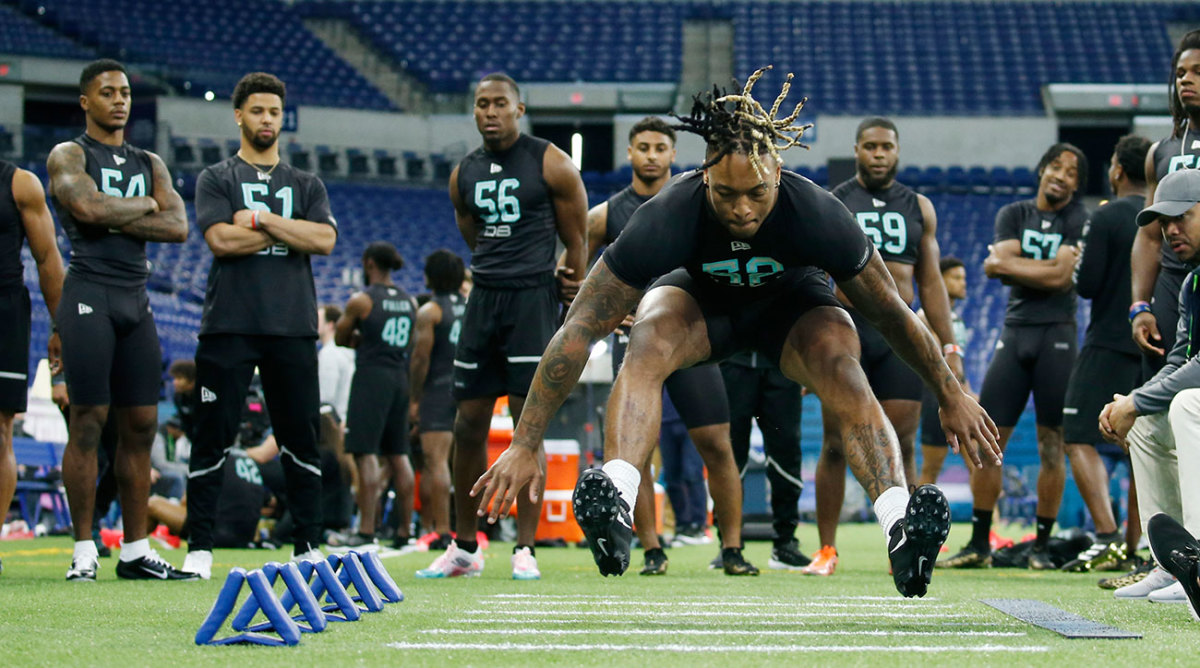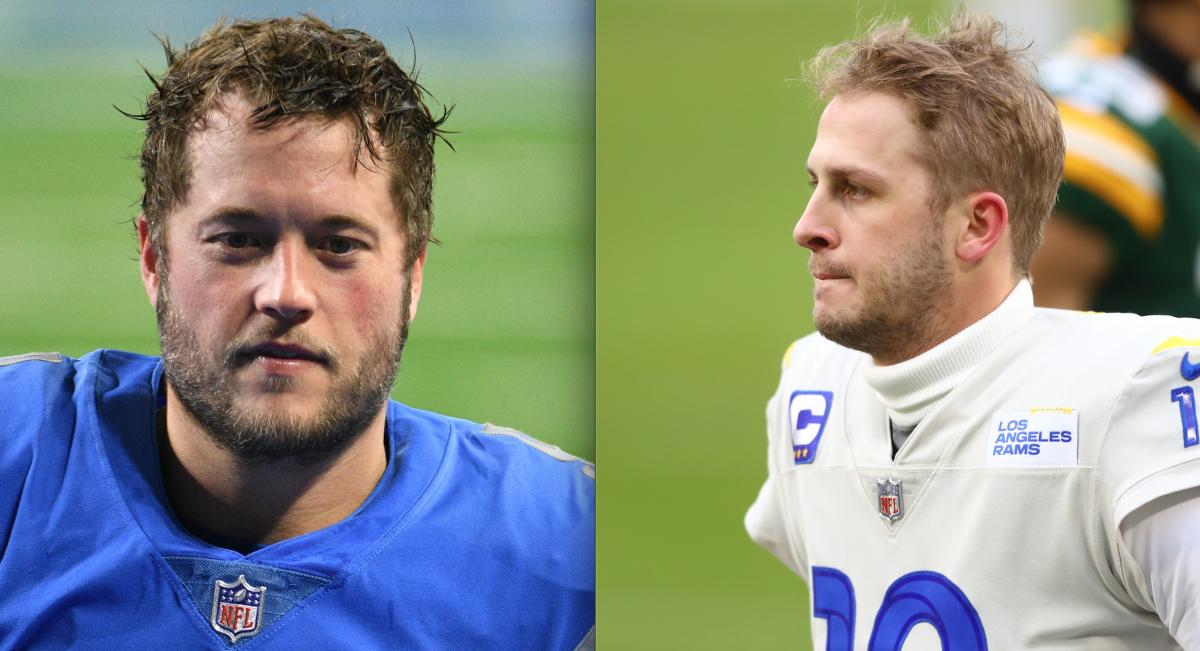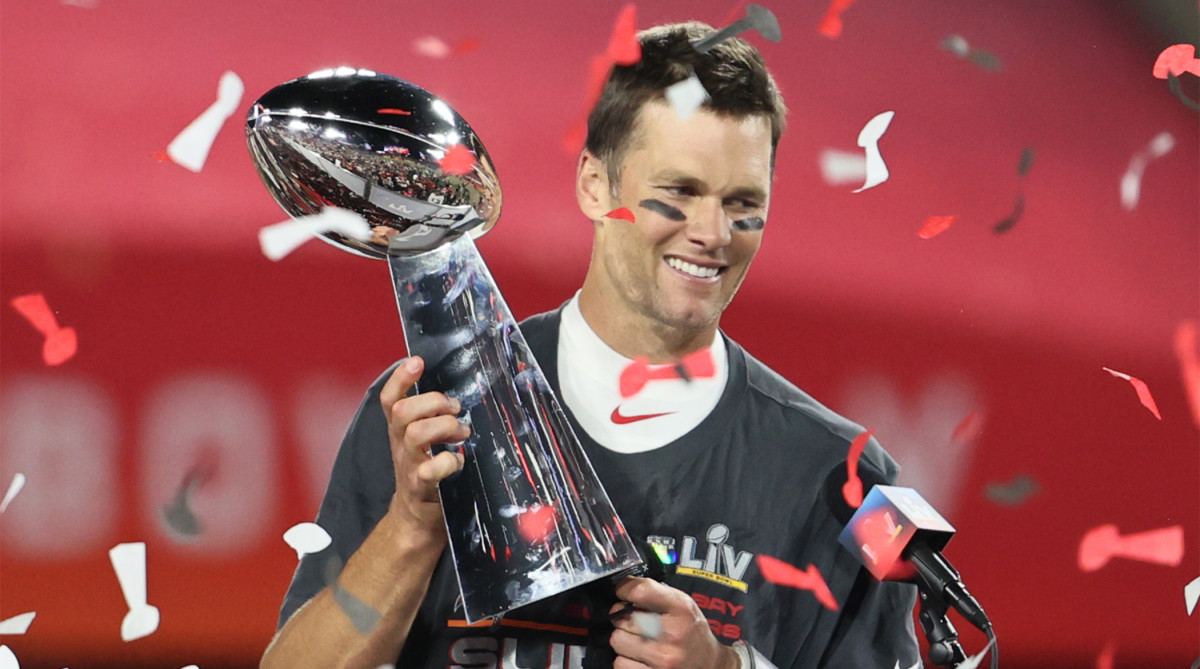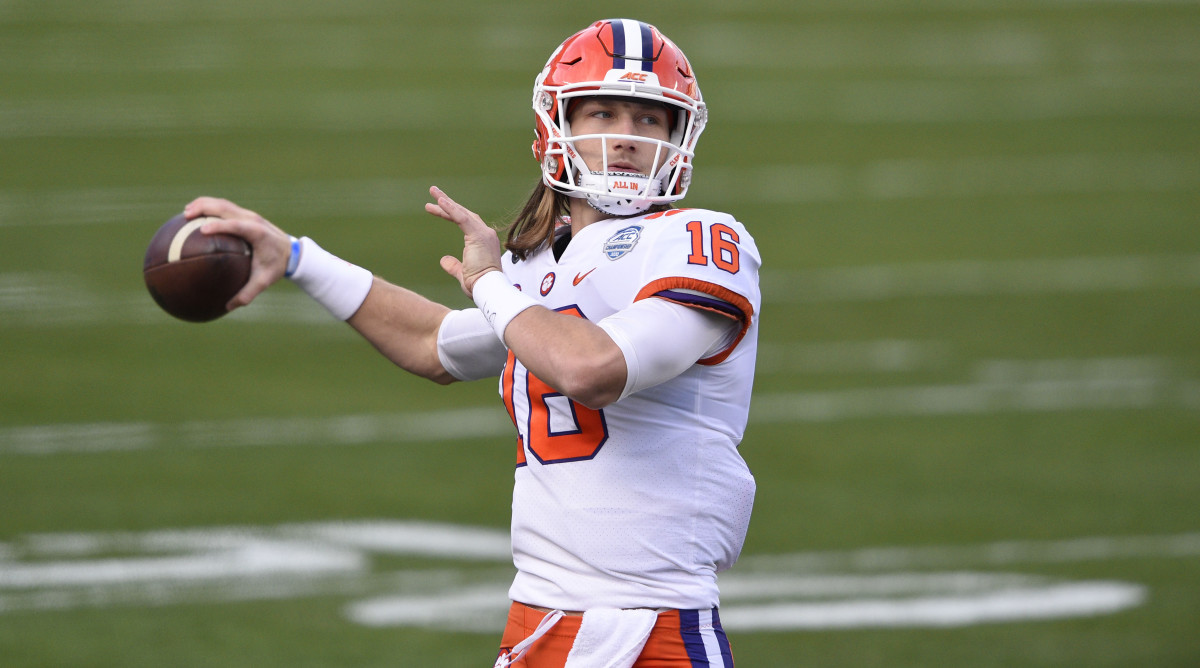NFL Execs Discuss Top Story Lines of Another Unusual Offseason
Back in mid-July, we were all headed into the great unknown—we didn’t know what training camp would look like, what testing would prove out, whether preseason games would be played or if even a single fan would be allowed in the stands. We’ve gotten answers to those questions since (more like regular practice; that football could be played; no; and yes), and now we’re back where we started.
The NFL offseason is underway. And it’s hard to say what’s ahead.
We can reasonably assume there’ll be free agency and a draft between now and mid-summer. What that will look like, and what comes in between, remains anyone’s guess.
That, as you might imagine, has created issues for scouting and coaching staff diving into draft and free-agent meetings this week. So how do you plan for—or in our case, preview—an offseason without knowing what shape it’ll take on a month from now, a month after that or a month after that?
Talking to teams the last three days to figure that out, the answer is really the same as it was back in the summer. Try to be open-minded. Be ready to adjust. Do a ton of homework. Look under every rock for ways to turn expected disadvantages into advantages gained over everyone else. In short, to steal what a coach might say on a Wednesday, stay loose and look alive.
And reminders of where we all are aren’t subtle. Scouts coming in from out of town and coaches coming back from vacation, for these meetings over the last week or two, had to clear three COVID-19 tests and then a rapid test to qualify to even have a seat in those rooms.
Which is to say before we even touch on the possibility of massive roster cuts because of the revenue shortfall due to COVID-19, a potentially robust trade market, the idea of unusual quarterback movement or how the draft process will once again be thrown in a blender, one truth needed to be confronted:
The 2020 season may be over and done with, but the challenges associated with it are not.
We’re here, still digging out from Super Bowl LV, and with the first GamePlan of the 2021 offseason. Inside the column, you’ll find …
• What Trevor Lawrence’s pro day will look like.
• How losing the combine will affect the NFL, in a way you wouldn’t think.
• Power rankings!
But we’re starting with a preview of the next few months. Let’s dive into that.

The story of how staffers are getting tested and having to start the annual team-building process in a very unusual way was a jumping-off point for more on how different things still are—it went all the way down to how people have to learn to project their voices working in larger spaces than they’re accustomed to—during a handful of discussions I had on what’s coming with NFL decision-makers over the last two or three days.
But eventually, we did veer back to the question I was really looking to answer during these talks and text conversations: What will the top NFL story lines be for us to follow over the next five months?
What we’ll do here is give you a smattering of their answers, and then my feelings on where things could go.
NFC Exec 1: “The potential attempts to make the combine a traveling road show, like the draft, goes against the intended football role of combine. All 32 teams gathering in one spot for medical and interviews of top players, and getting eyeballs on them moving around. It really affects the consistency of medical info and the process.”
This, for the football people, really matters, and I learned that in doing a combine story back in 2013. Why? It’s the consistency of the data the teams have, which allows for all of them to make apples-to-apples comparisons going back to the 1980s.
Having the combine in Indy every year meant having guys run, jump, lift, do drills, interview and have medical evaluations in a similar environment to what a guy had in 2011, 2001 or 1991 (to the point where the change to FieldTurf in the RCA Dome, and then the move to Lucas Oil Stadium shook things up a little bit). That allowed teams to use decades of data to compare prospects and build guardrails in their processes.
“We have years of data to compare things against,” then Falcons GM Thomas Dimitroff said, in the aforementioned story. “So when we change, you risk throwing out that data—that’s the issue.”
This year, the NFL will try to replicate the combine by standardizing pro day workouts across the country. But that’s obviously not the same as seeing guys line up next to each other on the same field, going through the same drills, under the same conditions.
AFC Exec 1: “Biggest story right now is how low the salary cap will go and when will teams find out.”
We had the Super Bowl GMs, Tampa’s Jason Licht and Kansas City’s Brett Veach, on the podcast together last week, and they talked about the cap landing between $175 million (the floor) and $195 million, which is both a wide range and realistic way to look at it—the league’s ability to do TV deals before setting the cap will be key to how close they get to 2020’s cap figure of $198.2 million.
If you look at the cap-tracking sites (like Spotrac and Over the Cap), you’ll find that a group of about seven teams are going to need some serious maneuvering to get under: the Saints, Eagles, Rams, Falcons, Packers, Steelers and Chiefs. Then you have a few more, like the Raiders, Texans and Vikings, that could be O.K. or in a tight spot, depending on where the cap lands. And many others that will be in compliance without much breathing room.
As for the timing part of it, the fact that teams don’t know, and probably won’t know for a little while, does clog up activity a little bit—in that potential selling teams don’t know the capacity they’ll have to hold on to their own, and may want to wait for clarity so more teams might be involved.
AFC Exec 2: “How Joe [Douglas] handles [Sam] Darnold, the second pick, etc.”
The draft this year starts at No. 2, and the Jets’ domino will be a big one. GM Joe Douglas has fielded calls on Darnold and told teams to be patient with him—which at least tells you they are considering their options at the position. And part of that process for the Jets, of course, will be putting BYU’s Zach Wilson, Ohio State’s Justin Fields and North Dakota State’s Trey Lance up on the board against Darnold.
There really are three outcomes here, each of which will reverberate across the NFL. The first one is the Jets could hang onto Darnold and make the second pick available, which will give quarterback-needy teams like Carolina, Washington and Indianapolis an avenue to get a franchise guy. The second is the team could hang onto Darnold and draft a position player (Oregon LT Penei Sewell?), which puts Miami at No. 3 in the catbird seat. The third has the Jets trading Darnold, which opens up another QB option for those teams, and taking a QB.
It’s also worth mentioning that whoever has Darnold in May will face the deadline to pick up his fifth-year option (or not), and per the new CBA, those are now fully guaranteed.
NFC Exec 2: “The influence or perceived influence the QB position is having on decision-makers!”
We all saw what Aaron Rodgers said after the NFC title game, and what Russell Wilson said this week, and you’d be a fool not to consider the trend there—though I think the intention of those guys (who both knew exactly what they were doing) is a little different than you might think. It’s easy to interpret it, of course, as a player shooting his way out of town. I actually think it’s more of a warning shot than that.
Look at what Buffalo did in trading for Stefon Diggs, what the Bucs did in collecting experienced, accomplished skill players (Leonard Fournette, Rob Gronkowski, Antonio Brown) and what the Chiefs have done for the last two or three years (Sammy Watkins, Le’Veon Bell, Mecole Hardman, Clyde Edwards-Helaire, etc.) All acted with a sense of urgency, and Josh Allen, Tom Brady and Patrick Mahomes reaped the rewards.
I really think this is what Rodgers and Wilson were getting at, in basically instructing their teams to build with more urgency. Whether or not listening is a great idea for those teams is a fair question. But I feel very comfortable saying that this is where these guys are coming from. So it’ll be interesting to see where both guys stand, and what their teams have done, a couple months from now.
NFC Exec 3: “The uncertainty of the offseason program. It really sets young players back to not have an offseason, and possibly now two in a row. We/they need it badly for development, and health and safety. Similar to kids missing school, they don’t ever get to make that development time up. I think it’s extremely important that everyone involved makes it happen.”
Most coaches will tell you that Year 1 to 2 bridge is when players experience their biggest jumps. And if you look at the 2019 draft class, which lost much of that time in the early days of the pandemic, it’s actually proven out. There are examples of guys who made a big leap in Year 2 (Devin White is one, D.K. Metcalf is another), there are far more that seemed to flatline. And now those guys are facing a second offseason like that—which means the last normal offseason they had was as collegians in 2018.
Now you can throw the 2020 draft class into that mix, too, and wonder what it’ll mean for guys like Justin Herbert and Tua Tagovailoa, and some, like Andrew Thomas, Jeff Okudah and Isaiah Simmons, who hit some bumps in their transition to the pros.
I’ve heard a lot of people say that the 2020 season proves that the spring is unnecessary. Players are saying it, too. But I know a lot of football people who disagree with that notion, and some even pointed out to me that veteran players who are saying it benefit from young guys having their development slowed down. (It can work to extend the older guys’ careers, if younger players aren’t ready as fast.)
“Totally disagree with the idea that you don’t need a spring,” said one exec. “That’s about as ludicrous of an idea as I’ve ever heard.”
I don’t have a definitive answer on what’s right or wrong there. But I do know that generally the more time you spend on your job, the better you get at it. Especially if you’re young and just learning the ropes.
NFC Exec 4: “How open-minded people are to trades to create cap space. People think guys are gonna just get cut and signed by someone else with cap space. The thing is, most of the teams that have space have just enough cap space to sign their own guys back. So I think you’ll see teams moving guys in trades, so guys stay on current contracts.”
This exec predicted a game of chicken could be coming. And one that’s pretty easy to understand. Team A has to shed salary and looks to move a player. Team B is interested in the player but knows Team A will have to cut the player if it can’t trade him. Also, Team B knows the value of draft picks, which represent cheaper labor, is higher this year than it has been in years past.
The result, I believe, will be a buyer’s market, where you see pricey vets moved for low-end draft capital. In this case it would benefit Team A because it would shed the player’s salary, and give it another asset to be thrifty with to fill its roster out. It would benefit Team B because it would get the player on his current contract, before other teams get a chance to bid on him.
These calls, by the way, are already happening, though in a hypothetical kind of way (because of the uncertainty on just where the cap will land), with some of those cap-strapped teams like New Orleans, Pittsburgh and Minnesota having appealing pieces to sell.
AFC Exec 1: “How the spring scouting season will look leading up to the draft. No combine, limited attendance at pro days, no private workouts, no dinners, no in-person meetings, no 30 visits, etc.”
Someone raised this possibility to me yesterday: The Jaguars will probably draft Trevor Lawrence without owner Shahid Khan ever having shaken the kid’s hand. Think about that. Lawrence has a chance to be the franchise’s most important person for the next decade and a half. He’ll be fully guaranteed more than $35 million before he takes a snap. And the boss won’t have a chance, in all likelihood, to be face to face with him in any capacity.
That’s where we are.
Pro days are limited to three people per team (starting with Lawrence’s pro day on Friday). Top 30 visits where prospects come to NFL facilities are banned, as are in-person private workouts. In a lot of ways, that’ll make this year like last year, where the final five weeks of the process were limited to Zoom interviews. The difference is that at least last year teams got to meet with players in Indy at the combine.
That’s what made the Senior Bowl so valuable last month. It’s also why teams may be way more risk-averse this year when it comes to guys with character flags or medical flags, or raw prospects in need of a lot of development.

NFC Exec 3: “The [Matthew] Stafford trade was the biggest. Mainly because it set the bar (fairly or unfairly) for all of the other QB movement/compensation.”
Another executive brought up Deshaun Watson as the top story line, and a third raised Wilson’s situation in Seattle. So here’s my guess as to how it’ll play out—big offers will be made on the truly elite quarterbacks that have not been made available, and big prices will be asked for in return for guys who potential are available.
The Carson Wentz situation is a perfect example. The Eagles initially asked for the Stafford return with an eye on getting a first-round pick and maybe something else. That ask pushed some teams away from the table. Others that were truly interested in Wentz stuck around but haven’t come close to what Philly wants. The truth is the market didn’t cool for Wentz. The truth is simply that the gap between what Philly asked for and what other teams were willing to give up was considerable all along.
The pace of trade talks has revealed that. And the larger point here is that with so many teams toying with the idea of looking to upgrade at the position (The Mahomes Effect, which we’ve discussed), sellers have high hopes that prices will rise on good-not-great players.
Ultimately, if Houston or Seattle ever decided to move their guys (I don’t think they will, but we’ll see), they’d be able to bring home a king’s ransom. Obviously. What’s less obvious is what players like Wentz or Darnold might bring home. Which, again, explains why the Wentz fervor of a week ago didn’t produce a trade.
AFC Exec 3: “The NFL pushing for league-wide vaccination at the essential team staff level.”
We’re a few months off from this, of course. But vaccination would be a very big step in finding a way back to normal—and how the league handles it in wanting staff, players and coaches vaccinated will be pretty interesting, for sure.
That kind of sums up where the NFL is, and how strange all of this still is. Because if you’d told me a year ago, that players might need shots to show up for training camp in July of 2021, I’d probably have been very surprised about how we got there.
And yet, here we are.

POWER RANKINGS
So, to transition, our final top-five ranking, with one comment per team on where things go from here.
1) Tampa Bay Buccaneers (15–5): Really, to me, there are two sets of questions. First, do you tag Chris Godwin or Shaq Barrett? (I think it’ll be Godwin.) Second, how do you take care of third-contract free agents Rob Gronkowski and Lavonte David?
2) Kansas City Chiefs (16–3): The offensive line question is real. Eric Fisher and Mitch Schwartz are in their 30s and going into contract years. Austin Reiter is a free agent and turns 30 this year. Laurent Duvernay-Tardif might come back, but he’s another new thirtysomething. Add it up, and the line should be, at least, a draft focus.
3) Green Bay Packers (14–4): Really, the two questions are simple ones. How will Joe Barry change the dynamic in what the Packers are looking for defensively, with a Vic Fangio–style scheme coming in? And how will Green Bay get cap compliant? After that, we can talk about giving Rodgers a new weapon or two.
4) Buffalo Bills (15–4): Most of the team is under contract. The cap is healthy. And sure, maybe the offensive line or pass rush could add a piece or two, but that can be accomplished in the draft. Which leaves the big one: When will Josh Allen’s contract be extended? The Bills are very much exploring a deal with their QB now.
5) New Orleans Saints (13–5): Where do we start? The Saints are way over the cap, will likely have a quarterback competition (Taysom Hill vs. Jameis Winston), still have to sign Winston and have young stars both looking to get paid (Marshon Lattimore, Ryan Ramczyk) and ready to hit free agency (Trey Hendrickson, Marcus Williams). The Saints usually figure this stuff out. But there is a lot to work through here.

THE BIG QUESTION
Why is Trevor Lawrence throwing on Friday?
It’s a fair question. There’s pretty much zero chance that he’s going anywhere but Jacksonville, and he’s getting ready to have his left (nonthrowing) shoulder surgically repaired. So it’d seem the only thing he can possibly do is hurt himself. And yet, there he’ll be on Friday at Clemson’s indoor practice facility, throwing to a patched-together group of receivers for more than a dozen teams.
“Reason he wants to throw is he loves ball and he has nothing to hide,” said ex-NFL QB Jordan Palmer, who’ll run the pro day session. “They want me to throw, I’ll throw. Yeah, I’ll throw for everybody. Sounds great. For him, he could sit there and say, I’m not doing it and here’s why. And you gotta understand where I’m coming from too, my brother [Carson] was the surefire No. 1 pick, no doubt, he played in the Senior Bowl and threw at the combine, because, Give me a ball. I’d love to compete. I have nothing to hide. I love throwing.
“Trevor’s the same kind of guy. He loves to compete, has nothing to hide, confident as they come and loves doing it. It’s really simple for him. It wasn’t really even a discussion.”
Lawrence’s throwing group is, to be sure, a bit eclectic. Just one of his receivers was on Clemson’s roster last year—that’s Cornell Powell, a likely Day 3 pick who came on late last year with 45 catches for 825 yards and seven touchdowns over the Tigers’ last eight games. Charone Peake, an ex-Jet and Jaguar, now playing in Canada, who was at Clemson during the Deshaun Watson Era, will also be there to run routes, as will ex-Notre Dame receiver Chris Finke, who was on the Niners’ practice squad for part of this year.
The expected No. 1 pick will be working off a 50-throw script that will show his ability to play under center and off play-action, and emphasize his pocket movement and proficiency throwing on the move, from screen passes to deep shots. Lawrence hasn’t had the run-up that most quarterbacks do ahead of a pro day, because of the timing of all this, but he and Lawrence did get in two weeks of work in Orange County, and had a dry run Wednesday in South Carolina.
And while the Jaguars are probably the only team that needs to be in attendance—I’m told that new Jacksonville coach Urban Meyer is credentialed for the event and is expected to be there—at least seven of the teams picking in the top 10 are slated to show up. The Jets, Dolphins, Falcons, Eagles, Broncos and Panthers will have scouts on the ground, too. One of those teams told me they felt like they had to be there, just to get the chance to see Lawrence throw and value him, just in case. (Yeah, I know.)
And after it’s over, Lawrence will have his surgery, with the timing of all this an effort to be ready for training camp in July. The quarterback actually originally nicked the shoulder back in Week 2 of his sophomore year against Texas A&M and aggravated it at some point this season, giving him a good reason to get it taken care of once and for all now.
The upshot for all of us here? We get to see the first pick in the draft throw on what would be an otherwise sleepy Friday with the offseason just getting revved up.
WHAT NO ONE IS TALKING ABOUT
The effect the combine will have on free agency.
It’s interesting because there’s a lot of wink, wink stuff that happens in Indianapolis in February and, to some degree, that’s where the top of the market starts to crystallize. Given all the moving parts this year, with the cap and related cuts and trades, it was already going to be more difficult on teams and agents to project at what level deals will be done.
So I’ll make this educated guess, having talked to a few agents about it: I think we’ll see a lot of one-year, betting-on-myself sort of contracts.
We’ve been here before, too. At the beginning of the 2011 CBA, similar to what’s happening now, the league and union agreed to “smooth” the salary cap, which led to the cap staying relatively flat from 2011 to ‘13. In the final year of that period, two prominent corners drafted in the first round in 2008 hit free agency for the first time.
Both Aqib Talib and Dominique Rodgers-Cromartie had played well after being traded, and each expected to be rewarded for it. Their teams, because of the flat cap, decided to let them hit the market. Talib wound up signing a one-year deal for less than $5 million to stay in New England; Rodgers-Cromartie went to Denver on a one-year, $5 million deal, a result of each expecting new TV deals to lead to the cap starting to rise again in 2014.
It worked. A year later, both got paid. Talib replaced Rodgers-Cromartie in Denver on a five-year, $45 million deal. Rodgers-Cromartie signed with the Giants for $35 million over five years. And that can be instructive, in that players could bite the bullet this year with the expectation that the new broadcast deal could mitigate the pandemic-related revenue issue and lead to a much healthier environment in 2022.
THE FINAL WORD
I loved seeing Tom Brady cut loose at the parade on Wednesday. And as I see it, there’s a real benefit for him there, in that he’s so often seen as unapproachable by the public, and this 100% humanized him. Plus, he had an awesome time. Clearly.
